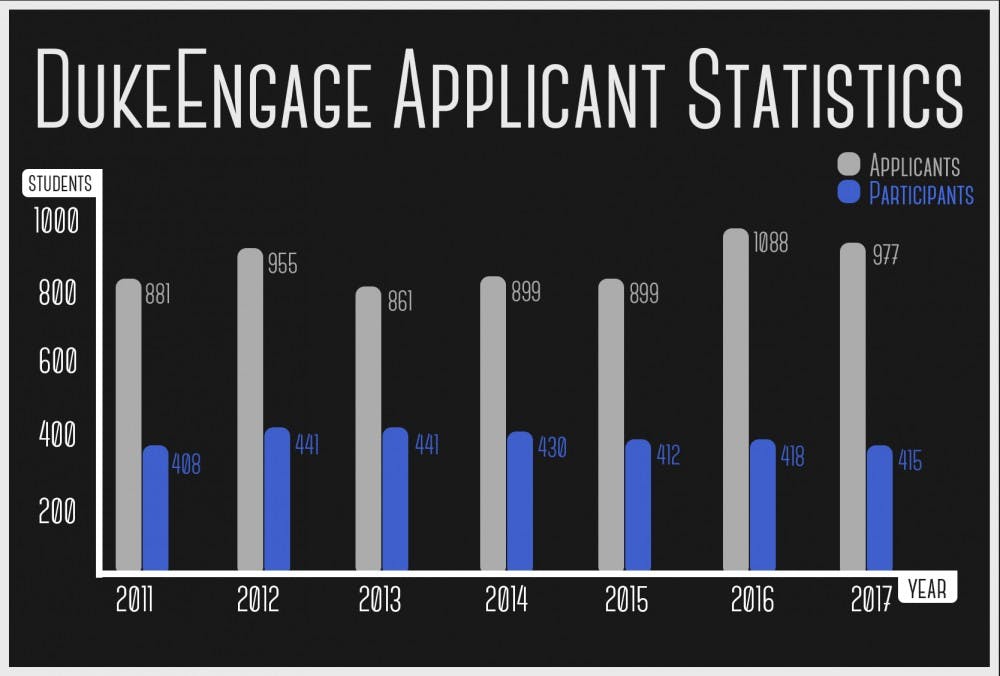As DukeEngage reaches its 10-year anniversary of fieldwork, the program celebrates new projects and increased funding—despite a continued plateau in both applicants and participants.
Each year since 2011, DukeEngage has received approximately 900 applications and accepted 400 to 450 participants. In 2017, the program received applications from 977 undergraduates—a slight drop from 1088 applications in 2016. The program’s strategic plan for 2017 set goals including 35 percent of DukeEngage participants serving domestically, 25 percent of the graduating class having participated in the program and having an enrollment size of 540. Only the first goal was reached this year.
“That was always an aspirational goal,” said Eric Mlyn, Peter Lange executive director of DukeEngage and assistant vice provost for civic engagement. “If all the circumstances lined up: if we had a lot of new programs to run, if we had a huge increase in funding, if we felt it was crucial for the level of impact that DukeEngage has on the university, we might get to that number.”
However, Mlyn noted that an enrollment size of 540 is a continued goal for the program. In 2013, the strategic plan committed DukeEngage to aim to enroll 600 students for by 2017, but that number was lowered to the current goal. Mlyn previously noted that the goal of 540 participants would likely not be met until DukeEngage received a substantial boost in funding.
DukeEngage started in the summer of 2007 after receiving a $30 million endowment by the Bill and Melinda Gates Foundation and the Duke Endowment of Charlotte. Since then, over 4,000 students have taken part in a DukeEngage program. Currently, more than 20 percent of the entire graduating class and about 23 percent of the Trinity graduating class have participated in DukeEngage.
Another strategic goal was to raise an additional $20 million as part of the Duke Forward campaign, a goal which Mlyn says the program surpassed.
Apart from the near-cancellation of DukeEngage programs in India in June, Mlyn says that the 10th year in the field was a very successful one.
“We had six new projects—all of which went very well—and we hope that all of those will repeat in summer of 2018. We have reemphasized domestic enrollment,” Mlyn said. “I’m very proud of how this summer went.”
The six new projects were located in Chile, Costa Rica, India, Rwanda, Uganda and Hawaii. Three of the six programs—Chile, Costa Rica and Hawaii—focused on environmental sustainability and conservation.
DukeEngage’s reemphasis on domestic programs reached many students, including sophomore Margaret Overton, who chose to apply to an environmental justice and climate change program in Portland, Ore.
“I chose to apply to a domestic program because of a conversation I had with an international student during my first semester at Duke,” Overton said. "In his words, he asked, ‘why are these Americans coming into my country thinking they can fix our problems? America has its own problems, you should focus on those first.’”
Despite these sentiments, DukeEngage’s international programs continued to attract many students, such as junior Iris Yang.
Yang said she chose to participate in DukeEngage-South Korea in order to work with and teach English to migrant and refugee children.
“My favorite part of the program was talking to North Korean defectors of all ages and backgrounds,” Yang said. “North Korea is a very mysterious country, but I knew that speaking to North Korean defectors would shed some light on the truths and myths surrounding the country.”
Junior Michael Saporito wanted to work in a Spanish-speaking country to help build his fluency in the language. This, along with his desire to work in a program focusing on community and global health, led him to choose DukeEngage-Ecuador.
“As my first time spent living in another country and experiencing another culture, I was able to learn so much,” Saporito said. “My work, though repetitive at times, had a direct impact on the community in that patients were able to see the doctor faster. I couldn’t be happier with my summer.”
One difficulty that Saporito faced was that his stipend did not factor in the cost of the additional bus transportation and extra expenses of working in a peripheral medical subcenter.
“It’s frustrating that there was no reasonable way we could get a sufficient lunch without paying out of pocket,” he said. “Granted, eating with the doctor every day was a wonderful way to know him better and better understand Ecuadorian culture."
However, Saporito explained that other students in this scenario may not have been as financially able to pay for those lunches, and would have missed out on deeper insight.
"I learned just as much in those lunch conversations as I did in my service, and I feel Duke didn’t take into consideration the differing costs associated with each worksite,” he said.
Get The Chronicle straight to your inbox
Sign up for our weekly newsletter. Cancel at any time.
Despite having some areas to improve, Mlyn noted that DukeEngage has come a long way in a decade.
“I hope that the entire Duke community takes a moment this Fall to celebrate and congratulate what we’ve built together and what has become a well-recognized, signature program of the university,” he said.

